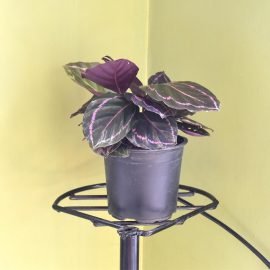Haworthia reinwardtii – Zebra Wart Succulent Plant
₹390.00
Haworthia reinwardtii – Zebra Wart Succulent plant is a great choice for your home or office desk or an indoor succulent garden. A small cute plant which is attractive on small containers. perfect succulent plant for a tabletop miniature garden or rock garden
- Evergreen Slow-growing succulent
- Easy to care
- Easy to propagate
- Perfect gift item
Pack contains
One Zebra Wart plants with 3″ plastic pot ( Pot colour may vary)
Plant size: 4 Inch (Approximately)
Plant with Pot – Approximately 7 Inch
Haworthia reinwardtii – Zebra Wart Succulent plant is a great choice for your home or office desk or an indoor succulent garden. It is an evergreen, easy to grow household succulent Plant. Above all, this cute plant rarely affected by common succulent pests and diseases. in fact, this slow-growing zebra wart is particularly hard to kill. It also propagates easily, which makes it perfect for arrangements or gifts.
Zebra Wart is a small, slow-growing, perennial succulent, with stems that can grow up to 8 inches high. The Zebra Haworthia forms a rosette of white-spotted, fleshy leaves in a spiral pattern. Leaves are large at the bottom and narrow as they curve upwards. This succulent blooms with tubular, pinkish-white flowers in the spring.
Being a small succulent, Haworthia can be planted in attractive small containers. Just make sure the soil can properly drain. Haworthia spreads in the form of a mat and produces freely growing offsets, which makes this succulent really easy to propagate.
The Haworthia reinwardtii is frequently confused with “Haworthia coarctata”, which has smaller, smoother and rounder tubercles on leaves. Haworthia reinwardtii has thinner, narrower leaves with larger, flatter and white tubercles.
Scientific Name: Haworthia reinwardtii Haw.
Common Name: Zebra wart, Wart Plant
Family: Asphodelaceae
Origin: Native to South Africa
Flowering: Blooms in the Spring. Small tubular pinkish-white flowers that grow on a tall, thin stem.
Benefit: Indoor plant, due to it’s the smaller size it is great for growing in a miniature garden, and rock and fairy gardens
Haworthia reinwardtii – Zebra Wart Care
Haworthias are easy to grow as long as you keep in mind that they are succulents and require the appropriate light, temperature, soil, and watering.
Light: Partial/filtered sun or Low Indoor Light. Direct sun can burn the leaves. Leaves will turn into white or Yellow.
Soil: Use well-drained soil and provides plenty of air to the small roots. Use a cactus mix or potting soil mixed with perlite and sand. If there are no draining holes on a container, make sure to add some gravel, to prevent root rotting.
Water: Water once every two weeks, letting the soil media dry out between waterings in the summer. Water them more in spring and summer and less in winter. In the winter, reduce watering to every other month. Zebra plant’s leaves are storage organs and roots are drought-tolerant. The root will grow if they have great drainage and deep, infrequent water when the soil is fully dry. Never allow water to gather in the rosette.
Temperature: Normal room humidity will suffice. 65°F – 80°F (8°C – 26°C) temperatures are very good and not below 50°F (10°C).
Fertilizer: Not necessary. During summer you can feed Zebra wart Plants with a diluted liquid fertilizer/cactus fertilizer occasionally. Do not feed during winter.
Repotting: Once the Zebra Plant outgrows the pot you can re-pot, during spring. Only move to a slightly bigger pot.
Propagation: Zebra wart Plants are propagated by leaves cutting or through the pups or offsets which can be removed from the mother plant or seeds.
| Weight | 150 g |
|---|---|
| Dimensions | 10 × 10 × 20 cm |
Be the first to review “Haworthia reinwardtii – Zebra Wart Succulent Plant” Cancel reply
You must be logged in to post a review.
This site uses Akismet to reduce spam. Learn how your comment data is processed.
Related products
Foliage Plants
Indoor Plants


















Reviews
There are no reviews yet.